
About UsThe Numismatic Bibliomania Society is a non-profit association devoted to the study and enjoyment of numismatic literature. For more information please see our web site at coinbooks.org SubscriptionsThose wishing to become new E-Sylum subscribers (or wishing to Unsubscribe) can go to the following web page link MembershipThere is a membership application available on the web site Membership Application To join, print the application and return it with your check to the address printed on the application. Print/Digital membership is $40 to addresses in the U.S., and $60 elsewhere. A digital-only membership is available for $25. For those without web access, write to: Charles Heck, Treasurer
AsylumFor Asylum mailing address changes and other membership questions, contact Terry at this email address: terrywhite5475@yahoo.com SubmissionsTo submit items for publication in The E-Sylum, write to the Editor at this address: whomren@gmail.com BUY THE BOOK BEFORE THE COINSale Calendar |
- WAYNE'S WORDS: THE E-SYLUM JULY 14, 2019
- CNG LITERATURE SALE CLOSES JULY 24, 2019
- NEW BOOK: THE ANILLO RESTRIKES
- FEDERAL RESERVE BANK PUBLICATIONS
- VIDEO: THE STORY OF NERO THROUGH HIS COINS
- VIDEO: PEOPLE ATTENDING KANSAS CITY IPMS
- SHEARED SILVER INGOT ANSWERS
- NOTES FROM E-SYLUM READERS: JULY 14, 2019
- MORE ON NEW YORK CITY NUMISMATIC TOURS
- VOCABULARY TERM: DECORATIONS OF HONOR
- JOHN CALVIN GITCHELL (1828-1868)
- SILVER DOLLAR KING JOHN HIGHFILL
- ROYAL CANADIAN MINT ARTIST CLAIRE WATSON
- HARVEY STACK'S NUMISMATIC FAMILY, PART 48
- HONG KONG COIN SHOW AUGUST 23-25, 2019
- STEPHEN ALBUM 4TH INTERNET-ONLY AUCTION
- NUMISMAGRAM MEDAL SELECTIONS: JULY 2019
- ARCHIVES INTERNATIONAL SALE #54 SELECTIONS
- FOURTH GARRIDEB NUMISMATIC SHERLOCKIAN DINNER
- CANADA'S FIRST COINS
- UNOFFICIAL BORDER PATROL CHALLENGE COIN
- COINS OF THE REPUBLIC OF MINERVA
- THE CASASCIUS PHYSICAL BITCOIN
- WHEN WAS THE FIRST EMPEROR NORTON SCRIP ISSUED?
- THE COLORBLIND COUNTERFEITER
- COLLECTIBLE STOCK AND BOND CERTIFICATES
- LOOSE CHANGE: JULY 14, 2019
- FEATURED WEB SITE: COINFLATION
Click here to access the complete archive a
Click here to unsubscribe (scroll down)
To comment or submit articles, reply to whomren@gmail.com
Content presented in The E-Sylum is not necessarily researched or independently fact-checked, and views expressed do not necessarily represent those of the Numismatic Bibliomania Society.
WAYNE'S WORDS: THE E-SYLUM JULY 14, 2019
 New subscribers this week include: Renee Martin. Welcome aboard! We now have 5,946 subscribers.
New subscribers this week include: Renee Martin. Welcome aboard! We now have 5,946 subscribers.
Thank you for reading The E-Sylum. If you enjoy it, please send me the email addresses of friends you think may enjoy it as well and I'll send them a subscription (but let me know if they are located in the European Union). Contact me at whomren@gmail.com anytime regarding your subscription, or questions, comments or suggestions about our content.
This week we open with a numismatic literature sale, a new book, four Federal Reserve monographs, two videos and comments from readers.
Other topics this week include sheared silver ingots, New York City numismatic tours, orders, medals and decorations, Canadian mint artist Claire Watson, researcher Robert Martin, auction selections, an unofficial Border Patrol challenge coin, rare physical bitcoins, and new information about Emperor Norton's scrip.
To learn more about the Anillo restrikes, Ben Franklin and paper money, the story of Nero, foreign-born people on U.S. paper money, R.L. Miles Jr., the 1917 China cloth note, Canada's first coins, and the colorblind counterfeiter, read on. Have a great week, everyone!
Wayne Homren
Editor, The E-Sylum
CNG LITERATURE SALE CLOSES JULY 24, 2019
Ancient and World coinage dealer CNG has announced their Summer 2019 numismatic literature sale. -Editor
Classical Numismatic Group, LLC is pleased to announce their Summer 2019 Literature Auction, featuring 266 lots and closing on Wednesday, 24 July 2019, beginning at 10 AM ET. This sale presents an exceptional selection of literature, with a particularly good offering of volumes from the Sylloge Nummorum Graecorum series, full runs of BMC Greek and RIC, an impressive run of the Numismatic Chronicle, and over sixty lots of auction catalogs. Nearly complete sets of CNG's printed sales and fixed price lists are also on offer. Please visit www.cngcoins.com to view the entire sale.
Two of the many highlights from CNG's Summer Literature Sale are:

Lot 88 [Traité] Babelon, E. Traité des monnaies grecques et romaines. (Paris;
Librairie Ernest Leroux, 1901-33). Three parts complete in five text and four plate volumes. Comprising; Première partie. Theorie et doctrine. Tome premier. Paris, 1901. 4to., pp. vii, 1206 double columns, (604 pages), errata, 37 text illustrations; Deuxième partie. Description historique. Tome premier. Comprenant les monnaies grecques depuis les origines jusqu’aux guerres médiques. Paris, 1907. Thick 4to., pp. iv, 1,670 double columns (836 pages), text illustrations; Tome deuxième. Comprenant les monnaies de l’empire des Perses Achéménides, de l’orient sémitique et de l’Asie-Mineure aux Ve et IVe siècles avant J.-C. Paris, 1910. Thick 4to., pp. iii, 1,559 double columns, (782 pages), errata, text illustrations, (2); Tome troisième. Comprenant les monnaies de la Grèce centrale et meridionale aux Ve et IVe siècles avant J.-C. Paris, 1914. 4to., pp. vi, (1), 1143 double columns (572 pages), a few illustrations in the text; Tome quatrième. Comprenant les monnaies de la Grèce septentrionale aux Ve et IVe siècles avant J.-C. Paris, 1932. 4to., pp. iv, 1,099 double columns (550 pages), (2); Troisième partie. Planches I à LXXXV. Paris, 1907. 4to., pp. (4), iii, (1), 85 very fine plates; Planches LXXXVI à CLXXXV. Paris, 1910. 4to., pp. 8 double columns, (4 pages), 100 very fine plates; Planches CLXXXVI à CCLXX. Paris, 1916. Reprinted, 1967. 4to., pp. (4), 6 double columns, (4 pages), 85 scanned plates; Planches CCLXXI à CCCLV. Paris, 1926–1932. 85 very fine plates.
All nine volumes uniformly bound in recent maroon cloth, black morocco titles to spines, gilt. With a hand written letter dated July 2nd 1900 bound into the first volume and sent on behalf of the publisher, Ernest Leroux, to an unnamed recipient (perhaps Babelon?) enquiring after the preferred paper format and stating that the previous paper specimens did not meet with Mr Leroux's approval and that new examples were being sent for his consideration. Very Fine condition. An attractive set of Babelon's magnum opus, originally conceived of as a complete corpus of Greek and Roman coins and described by Clain-Stefanelli as Babelon's ‘greatest work.' Rarely offered, especially complete and in such fine condition as here. Estimated at $10,000
Clain-Stefanelli 1809*, “An unfinished but monumental work, indispensable for the scholar.” Daehn 19. Kroh p. 8. Grierson p. 45-46, “Une mine de renseignements sur toute l’organisation monétaire antique.” And p. 52, “Conçu d’après un plan monumental, mais inachevé. Couvre l’ensemble de la Grèce classique, sauf la Grande Grèce et la Sicilie, jusqu’à l’avènement d’Alexandre le Grand.”
From the Numismatic Library of a Major North American Dealer.
 Lot 151–Gnecchi, F. I medaglie romane. Volume primo. Oro ed argento. Volume secondo. Bronzo. Parte prima: Gran modulo. Volume terzo. Bronzo. Parte
seconda: Moduli minori. Parte terza: Medalioni del senato. (Milano: Ulrico Hoepli, 1912). Complete in three volumes. Large 4to. fine portrait of the author
as frontispiece, titles printed in red and black, lxviii, 83, (1), (4); (16), 158, (1), (5); (16), 234, (6); 162 superbly printed plates. All three volumes
bound in quarter morocco and marbled boards, raised bands, gilt. Marbled endpapers throughout. From the libraries of Joel L Malter, and Edward Newell with the
former's ex-libris on the front pastedown of the second volume only, and Newell's present in each. Fine condition, a well used set, the binding now weak with
the hinges of volume two and some pages loose, a number of pages chipped with tears and nicks throughout. Still a handsome set, which would benefit from the
attention of a skilled binder. A monumental and unsurpassed work, very rarely offered. Estimated at $6,000 Clain-Stefanelli 4963*. Grierson p. 84, “Corpus de
toutes les pieces connues à l'époque.”
Lot 151–Gnecchi, F. I medaglie romane. Volume primo. Oro ed argento. Volume secondo. Bronzo. Parte prima: Gran modulo. Volume terzo. Bronzo. Parte
seconda: Moduli minori. Parte terza: Medalioni del senato. (Milano: Ulrico Hoepli, 1912). Complete in three volumes. Large 4to. fine portrait of the author
as frontispiece, titles printed in red and black, lxviii, 83, (1), (4); (16), 158, (1), (5); (16), 234, (6); 162 superbly printed plates. All three volumes
bound in quarter morocco and marbled boards, raised bands, gilt. Marbled endpapers throughout. From the libraries of Joel L Malter, and Edward Newell with the
former's ex-libris on the front pastedown of the second volume only, and Newell's present in each. Fine condition, a well used set, the binding now weak with
the hinges of volume two and some pages loose, a number of pages chipped with tears and nicks throughout. Still a handsome set, which would benefit from the
attention of a skilled binder. A monumental and unsurpassed work, very rarely offered. Estimated at $6,000 Clain-Stefanelli 4963*. Grierson p. 84, “Corpus de
toutes les pieces connues à l'époque.”
From the Numismatic Library of a Major North American Dealer. Ex Malter Galleries Inc., Auction #88 (4th June 2006), lot 781.
CNG is currently accepting consignments for future auctions sales. Please contact the firm for further details and consignment deadlines. For further details and any additional information, please contact CNG, LLC at:
Classical Numismatic Group, LLC
P.O. Box 479
Lancaster, PA 17608-0479
Telephone: (717) 390-9194
Fax: (717) 390-9978
Email: cng@cngcoins.com

NEW BOOK: THE ANILLO RESTRIKES
Richard Greever of the TokenCatalog.com has released his catalog on the Anillo Restrikes. There are two versions, the full catalog and a shorter basic version. Both are available for review online. Payment is optional (but I would encourage users to do so - support your authors and researchers)! -Editor
 The Anillo Restrikes – An Illustrated Catalog
The Anillo Restrikes – An Illustrated Catalog
By Richard Greever
3548 Distinct Anillo Restrikes Cataloged
Electronic Distribution Only – 2248 Pages
There is a full version, which is the catalog I was trying to produce, and a shorter version for those who don't want (or need) the full catalog.
Table of Contents
Introduction
Appendix A – Alphabetical Listing of Anillo Restrikes
Appendix B – Alphabetical Listing of Anillo Restrikes – Large Images
Appendix C – Listing of Anillo Restrikes by Location
Appendix D – Anillo Restrike Images – Side-By-Side Images of All Duplicates
Appendix E – Anillo Restrikes with Missing Images – Images Needed
The short version only contains the Introduction & Appendix A, which would be the "Basic Catalog".


Both the full catalog and the short catalog are available for free download. There is the option to "purchase" after the fact, it the user is so inclined.
Delivered as a PDF download with embedded index to speed searches.
It is available by a link on the home page of the TokenCatalog.com site.
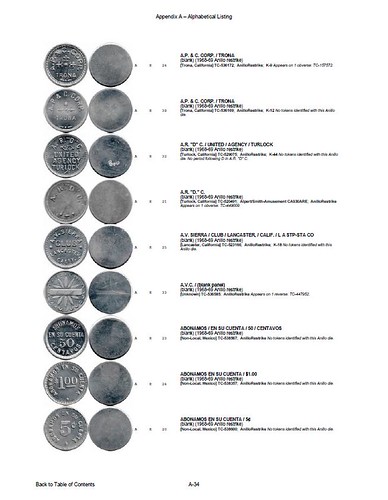

Richard adds:
"I hope this of interest to the E-Sylum readers. Due to size/cost, I have no intention to print, which perhaps disqualifies this as a book... I hope the information proves useful to the hobby and future researchers."
A book is a book, whether it's in hardcopy or electronic. Thanks for your efforts! It's a specialty within a specialty, yet still part of the greater fabric of world numismatics. -Editor
To read an earlier E-Sylum article, see:
THE ANILLO TOKEN RESTRIKES (https://www.coinbooks.org/v20/esylum_v20n54a24.html)

FEDERAL RESERVE BANK PUBLICATIONS
Ronald Fritz writes:"The various Federal Reserve banks occasionally publish booklets or articles that would be of interest to numismatists. Here are links to some article/pamphlets published by the Federal Reserve Bank of Philadelphia."
Thanks. There are a number of these that have been published and distributed over the decades, but I'm not aware of a bibliographic listing of all of them. That would be a useful guide for including them on the Newman Numismatic Portal as a central repository. Does anyone have a list of these, or know where to find one?
Here are the ones hosted on the Philadelphia Fed site. -Editor
Benjamin Franklin And the Birth of a Paper Money Economy
 Benjamin Franklin's life spans most of the first epoch of paper money, and he is its most insightful analyst and ardent defender. He did not create
the first paper money in America, nor was he yet born when it was first used. However, these early experiments with paper money, beginning in 1690 in New
England and in the first two decades of the 18th century in the Carolinas, New York, and New Jersey, were limited emergency wartime exercises, temporary in
design. Beginning in the 1720s colonial legislatures began to move toward issuing paper money with a view to making it a permanent fixture within their
colonies. Pennsylvania was an important leader and the most successful colony in this movement. It is the birth of this permanent peacetime paper money supply
that Franklin will affect.
Benjamin Franklin's life spans most of the first epoch of paper money, and he is its most insightful analyst and ardent defender. He did not create
the first paper money in America, nor was he yet born when it was first used. However, these early experiments with paper money, beginning in 1690 in New
England and in the first two decades of the 18th century in the Carolinas, New York, and New Jersey, were limited emergency wartime exercises, temporary in
design. Beginning in the 1720s colonial legislatures began to move toward issuing paper money with a view to making it a permanent fixture within their
colonies. Pennsylvania was an important leader and the most successful colony in this movement. It is the birth of this permanent peacetime paper money supply
that Franklin will affect.
No other American was involved over as long a period of time with so many different facets of colonial paper money as was Benjamin Franklin — certainly no other American with such a preeminent stature in science, statesmanship, and letters. Franklin arrived in Philadelphia the year paper money was first issued by Pennsylvania (1723), and he soon became a keen observer of and commentator on colonial money. He wrote pamphlets, treatises, and letters about paper money. He designed and printed paper money for various colonies. He entertained ideas about and proposed alternative monetary systems. As an assemblyman for the colony of Pennsylvania, he was involved in the debates during the 1740s and 1750s over the management of that colony's paper money. As a lobbyist for various colonies to the British court, he dealt with conflicts over colonial paper money that arose between Britain and her colonies in the 1760s and 1770s. Finally, at the end of his life as one of the preeminent Founding Fathers at the 1787 Constitutional Convention, he participated in constitutionally ending the first epoch and so helped usher in the second epoch of paper money in America. Franklin is arguably the preeminent authority on paper money in America in this period.
To read the complete publication, see:
Benjamin Franklin And the
Birth of a Paper Money Economy (https://www.philadelphiafed.org/-/media/publications/economic-education/ben-franklin-and-paper-money-economy.pdf?la=en)
The First Bank of the United States
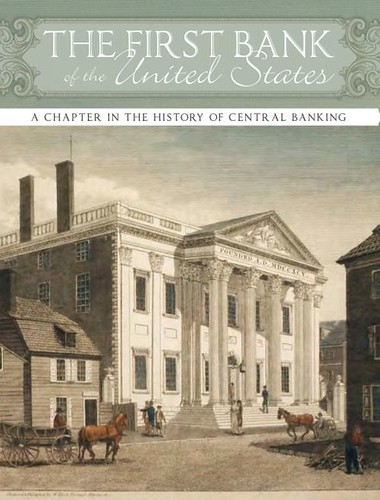 One prominent architect of the fledgling country — Alexander Hamilton, the first Secretary of the Treasury —had ideas about how to solve some of
these problems. Unlike other founding fathers, who thought that the United States should remain primarily agricultural, Hamilton researched the history and
economic structure of other countries, especially France and Britain, for ideas on how to build a nation. Although Hamilton culled valuable information about
public finance from the writings of French Minister of Finance Jacques Necker, it was England — America's recently defeated colonial overlord — that provided
Hamilton with sound foundations for creating a viable economic system.
One prominent architect of the fledgling country — Alexander Hamilton, the first Secretary of the Treasury —had ideas about how to solve some of
these problems. Unlike other founding fathers, who thought that the United States should remain primarily agricultural, Hamilton researched the history and
economic structure of other countries, especially France and Britain, for ideas on how to build a nation. Although Hamilton culled valuable information about
public finance from the writings of French Minister of Finance Jacques Necker, it was England — America's recently defeated colonial overlord — that provided
Hamilton with sound foundations for creating a viable economic system.
To read the complete publication, see:
THE FIRST BANK OF THE UNITED STATES
(https://www.philadelphiafed.org/-/media/publications/economic-education/first-bank.pdf?la=en)
The Second Bank of the United States
 But the First Bank's 20-year charter had expired in March 1811. So by January 1815, the country had been without a national bank for almost four
years. Many people thought that another national bank would again provide relief for the country's ailing economy and help in paying its war debt.
But the First Bank's 20-year charter had expired in March 1811. So by January 1815, the country had been without a national bank for almost four
years. Many people thought that another national bank would again provide relief for the country's ailing economy and help in paying its war debt.
Six men figured prominently in establishing the second Bank of the United States (commonly called the Second Bank): financiers John Jacob Astor, David Parish, Stephen Girard, and Jacob Barker; Alexander Dallas, who would become Secretary of the Treasury in 1814; and Representative John C. Calhoun of South Carolina. These men thought that re-establishing a national bank would solve some of the country's economic woes.
To read the complete publication, see:
THE SECOND BANK OF THE UNITED STATES
(https://www.philadelphiafed.org/-/media/publications/economic-education/second-bank.pdf?la=en)
THE STATE AND NATIONAL BANKING ERAS
 After the second Bank of the United States closed its doors in 1836, the United States went through a period of approximately 76 years during which
it had no central bank.
After the second Bank of the United States closed its doors in 1836, the United States went through a period of approximately 76 years during which
it had no central bank.
Instead, the U.S. banking system during this time is generally divided into two periods: the state, or free, banking era, which ran approximately from 1837 to 1863, and the national banking era, which lasted roughly from 1863 to 1913. Also, the United States still had no uniform national currency. State-chartered banks issued their own banknotes, and some nonfinancial companies issued notes that also circulated as currency. For example, railroads issued notes to fund construction projects, and other companies such as the New Hope Delaware Bridge Company were allowed to issue notes as well. Both the railroad and bridge company notes were used as currency.
To read the complete publication, see:
THE STATE AND NATIONAL BANKING
ERAS (https://www.philadelphiafed.org/-/media/publications/economic-education/state-and-national-banking-eras.pdf?la=en)

VIDEO: THE STORY OF NERO THROUGH HIS COINS
The latest addition to the Newman Numismatic Portal is a new educational video by Lianna Spurrier. Project Coordinator Len Augsburger provided the following report. The coin illustrated is RIC Nero 46. -Editor
 Lianna Spurrier is back at it again, with a video entitled “The Story of Nero Through His Coins.” Nero is remembered as a bloodthirsty, ruthless, and
immoral ruler. But was he really that bad? His coins indicate there is more to the story than the stereotypical narrative. While there is good reason for his
barbaric reputation, Nero was surprisingly interested in the arts and the enrichment of cultural life. Ms. Spurrier digs in further in this well-produced
video.
Lianna Spurrier is back at it again, with a video entitled “The Story of Nero Through His Coins.” Nero is remembered as a bloodthirsty, ruthless, and
immoral ruler. But was he really that bad? His coins indicate there is more to the story than the stereotypical narrative. While there is good reason for his
barbaric reputation, Nero was surprisingly interested in the arts and the enrichment of cultural life. Ms. Spurrier digs in further in this well-produced
video.
Link to “The Story of Nero and His Coins” on Newman Portal:
https://nnp.wustl.edu/library/multimediadetail/529486?Year=2019&take=50
VIDEO: PEOPLE ATTENDING KANSAS CITY IPMS
These are selections from the David Lisot Video Library that feature news and personalities from the world of coin collecting. David has been attending coin conventions since 1972 and began videotaping in 1985. In 2017 the Newman Numismatic Portal reached an agreement to list all David's videos on their website. Each week an excerpt of a different video is available on the CoinTelevision YouTube channel.
Here's one on people attending the Kansas City International Paper Money Show. -Editor

People Come from All Over the World to Kansas City International Paper Money Show.
This video is a highlight from International Paper Money Show. The IPMS has non-stop action for those who collect, investigate, buy, sell, and trade paper money and banknotes of the world. Participants can see world class competitive exhibits and attend lectures sponsored by the major bank note organizations delivered by the best researchers in the paper money industry. If you want to talk paper money you need to come to the IPMS!
The entire interview is available on the Newman Numismatic Portal at:
https://nnp.wustl.edu/library/multimediadetail/522852
An excerpt of the video is available for viewing on the Coin Television YouTube Channel at:
https://youtu.be/y30QXwortuc
People Come from All Over the World to Kansas City International Paper Money Show
VIDEO: 2:51
David Lisot, Interviewer, CoinTelevision.com, with Mark Anderson, Elaine Fung, Robin Hill, Dennis Lutz, Hugh Shull, and Tony Weldon.

SHEARED SILVER INGOT ANSWERS
In response to the earlier article about Ken Conaway's Silver Ingots of the United States Government web site, Max Hensley asked, "What were the shear ingots made for? Can the serial numbers be correlated with dates of issue, who were these sold to? " Ken provided this response. -Editor
I have found absolutely no information on what the starting sheets of fine silver were made for. Given the numbers of cuts (or sheers) on the ingots I have examined, and the fact these exist on all edges of most ingots, the original plates had to be of some substantial size. These large plates were stamped with the Type III large oval hallmark which appears sheared through on the reverse of a number of examples. This does not seem like a logical way to cast silver since most commonly "bar shapes" were, and still are used. Great question and certainly one that remains high on my research list.
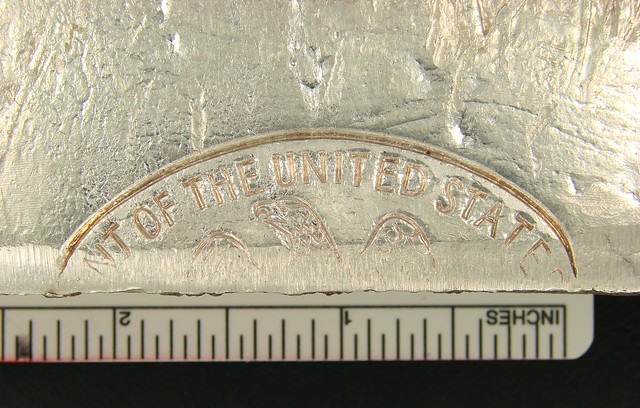
Moving beyond the original plate production, the distribution into the mainstream can be assumed to have occurred similarly to what is represented by the U.S. Mint Bar Delivery Receipt included in the San Francisco Sheared Plate page on SILVERINGOTS.COM https://www.silveringots.com/san-francisco/sheared-plate-ingots
For this very same ingot, No. 1767, I have a scrap silver deposit receipt, an assay and process invoice and the document pictured on the website, the bar delivery receipt. For this particular transaction, scrap silver wear was presented to have processed and in exchange, an equal weight of Sheared Plate ingots was returned to the customer.
Regarding dates of issue, the San Francisco Sheared Plate Registry dropdown under "Registries" https://www.silveringots.com/san-francisco/san-francisco-sheared-plate contains all of the dates that I have on these under the NOTES column. The No. 1 Sheared Plate ingot is dated 1952 on the reverse, No. 477 is dated 1954 on the reverse and from No. 1322 on I have found a few that are dated 1955 on the reverse.
All great questions and it is good to find another collector out there! Anyone that has any of these in their collection that is not included in the Registries please let me know and I will add them. Contact information at SILVERINGOTS.COM or kenconaway@aol.com
Thanks! -Editor
For more information, see:
San Francisco - Sheared Plate Ingots
(https://www.silveringots.com/san-francisco/sheared-plate-ingots)
To read the earlier E-Sylum article, see:
NOTES FROM E-SYLUM READERS: JULY 7, 2019 : Silver Ingot Questions
(https://www.coinbooks.org/v22/esylum_v22n27a11.html)
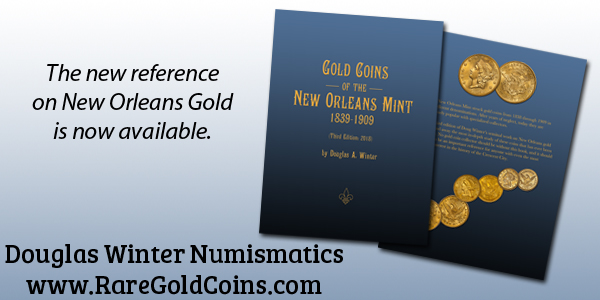
NOTES FROM E-SYLUM READERS: JULY 14, 2019
Znachki Photos
Bob Moeller writes:
I saw your posts on znachki and it prompts me to send you the link to my Instagram account, where I'm posting one a day from my collection.
https://www.instagram.com/sovietpinsrus/?hl=en
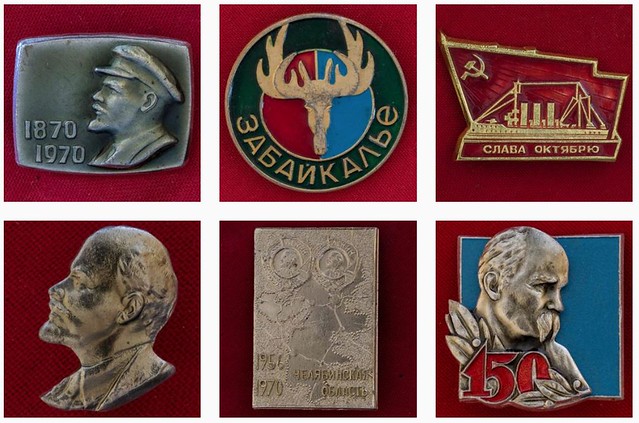
The site is devoted exclusively to Soviet pins, mass-produced for all occasions in the 1960s, '70s, and '80s.
Thanks. Znachki are colorful collectible Russian medallic propaganda pinbacks. -Editor
To read the earlier E-Sylum articles, see:
NEWMAN PORTAL ADDS ALASKAN ZNACHKI BULLETIN
(https://www.coinbooks.org/v21/esylum_v21n04a05.html)
SOVIET ERA RUSSIAN ZNACHKI (https://www.coinbooks.org/v21/esylum_v21n04a30.html)
More on the Paper Emergency Coins of Leiden
Jeffrey Zarit writes:
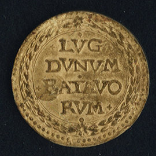 As a long time student of siege and obsidional issues, I have seen and handled many of these. The denomination for the one in the article is a Half
Gulden. This is the most commonly seen type. There also exists a one gulden (a type that I last handled about 4 years ago). If memory serves me it was about a
third larger than the ½ Gulden.
As a long time student of siege and obsidional issues, I have seen and handled many of these. The denomination for the one in the article is a Half
Gulden. This is the most commonly seen type. There also exists a one gulden (a type that I last handled about 4 years ago). If memory serves me it was about a
third larger than the ½ Gulden.
There also exists at least two and maybe more larger ones, the last one I saw and handled, about 40 years ago. I had two, and I think they were as large as a silver dollar or Thaler sized coin.
These were struck on Bible pages as this was the only thing available for these small denomination coins. There were other coins struck for the siege in silver, but this discussion is about the paper issues only. It is my understanding that Bibles of this period were made by a process known as illumination in which the type was large, some letters were not in black and the pages themselves were quite thick, the thickness of the coins struck. All were counter stamped with a lion, the mark of the province of Holland.
In my humble opinion, although of paper, these issues were made to circulate as coins. The people of Leyden (about 25 miles from Amsterdam, although I have not been there) needed coinage for everyday commerce while under siege from the Spanish. Certainly a very interesting item.
I will always be just a student as NO ONE knows it all. And I have always found square coins (and coins made out of paper) to be neat. Hence , when the internet started, my domain, is Klippes.com
Bouke Jan Van der Veen writes:
I did some internet searchng on American research in Leiden coins 1574. Very interesting, a lot of attention !
I came across another error ; the countermark applied was not "By order of Prince William of Orange ... " etc. That was the countermark of 1571/72 (tax to finance the war), but they used the same die to countermark the paper coins in Leiden 1574 ; the small die with the lion in a circle of pearls. The reason is very obvious : this countermark was still kept and available at the City Hall !!
This countermark was not for tax but only to show the users of the paper coins that they were genuine and no falsifications which were discovered shortly after distribution. It is also not true that the countermark was applied after the siege to make the coins invalid.
Thanks, gentlemen. -Editor
To read the earlier E-Sylum article, see:
THE PAPER EMERGENCY COINS OF LEIDEN (https://www.coinbooks.org/v22/esylum_v22n27a10.html)
Appreciating Robert Martin
Web site visitor Renee Martin writes:
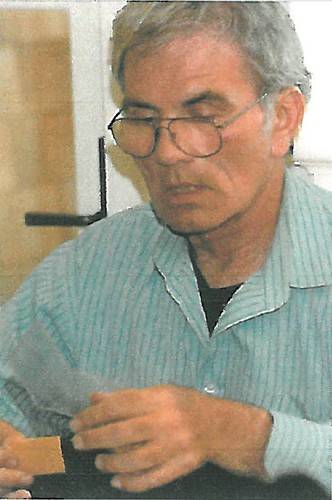 I am the niece of the late Robert Martin. As time goes by, more & more information about Robert's collection is becoming familiar to the
family. Uncle Bob would always visit us in Orange County NY where his brother John (whom just recently passed away) lived and would continuously try to educate
the family on his coins / collections. Uncle Bob would always have a few coins with him for show & tell. I knew it was a passion for Uncle Bob but only
since his passing did we realize how valuable it could be due to its rarity.
I am the niece of the late Robert Martin. As time goes by, more & more information about Robert's collection is becoming familiar to the
family. Uncle Bob would always visit us in Orange County NY where his brother John (whom just recently passed away) lived and would continuously try to educate
the family on his coins / collections. Uncle Bob would always have a few coins with him for show & tell. I knew it was a passion for Uncle Bob but only
since his passing did we realize how valuable it could be due to its rarity.
A magazine came to the house addressed to Robert last week titled "COINage". This morning I took the time to educate myself for the reason of the cover "Ultimate Secrets of the Coin Auctions" and found on page 22 a photo of the late Walter Breen who is in a section of one of your articles with a photo named "Midnight Sale" along with Uncle Bob. I did read this article shared with the family back in December 2017 and again today after reading through the magazine noted above. I was taken aback by the testimonials that Randy Clark, Mike Packard, Anthony & Mary Ann Terranova, Roger Siboni and Jack Howes wrote. Today it hit me that Bobby was very well liked by many and a huge educator in the coin world.
This hobby of Uncle Bobby's is completely like a puzzle being put together. I just wanted to share with you that we as a family appreciate the knowledge shared of Uncle Bob's coin life and a special Thank You to those noted above for sharing their memories
I didn't have the pleasure of meeting him since I don't actively collect colonials. But Robert Martin was known and respected at the highest levels of the hobby. -Editor
To read the earlier E-Sylum articles, see:
ROBERT MARTIN (1946-2017) (https://www.coinbooks.org/v20/esylum_v20n46a07.html)
MORE ON ROBERT MARTIN AND THE MIDNIGHT SALE
(https://www.coinbooks.org/v20/esylum_v20n48a17.html)
Foreign-Born People on U.S. Paper Money
Regarding Pat Heller's question about "people other than Christopher Columbus who are depicted on US currency issues that were not born in what is now
part of the United States of America," Ken Barr writes:
The Heller article you referenced uses the phrase "specifically named people". Under that criteria, the three remaining folks are probably (Englishman) General John Burgoyne (1863 $500 National Bank Note), (Spaniard) Hernando DeSoto (1918 $500 Federal Reserve Note) and (Englishman) Sir Walter Raleigh (1875 $2 National Bank Note).
There are numerous other non-Americans depicted on US currency, including King James I and Queen Anne, Brigadier General William Phillips and Lt. Gen. Baron Friedrich Adolph Riedesel, but they are not "specifically named" on the notes themselves, but rather identified from the original source of the vignettes in which they appear.

Surrender of General Burgoyne
Great question, and great answer as well. Answering these types of questions is often far more nuanced than it seems at first glance. There are often many details to be parsed and examined. Thanks! -Editor
To read the earlier E-Sylum article, see:
THE LIMITS OF INTERNET RESEARCH (https://www.coinbooks.org/v22/esylum_v22n27a05.html)
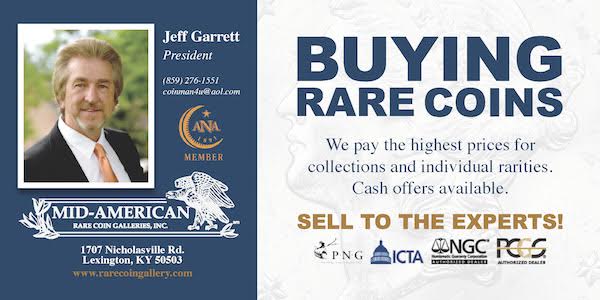
MORE ON NEW YORK CITY NUMISMATIC TOURS
Ronald Fritz submitted these thoughts on interesting numismatic tours in New York City. Thanks! -Editor

Museum & Gold Vault Tour
I enjoyed reading the ANA edition of The E-Sylum and would like to comment on the one about numismatic tours in New York City.
First, let me give you a little background on myself. I am a member of the ANA, paid through December 2020 at which time I will become an emeritus member, and two local coin clubs. I retired but spent thirty years as a banking regulator, mostly as a supervising bank examiner.
The tours that are discussed in the article appear to be mainly tours of the facades of buildings with a numismatic collection. One of the sites mentioned offers much more to the numismatist. In the early 1990's I attended a seminar for regulators at the New York Federal Reserve Bank. The last day of the seminar ended early and the Vice President of the New York Federal Reserve offered those of us who were interested a private tour of the bank's Gold vault. While U.S. gold reserves are held at Fort Knox, most of the free world's gold reserves are held at the New York Federal Reserve Bank in a large vault five floors below ground level, surrounded by bedrock. The gold is stored in 128 cages, each containing two to five thousand bars of gold (As I recall, one or two hold gold coins instead).
In 1996, as president of the Northern Valley Coin Club, I contacted the Federal Reserve and arranged for our group to tour the vault. Although not as extensive as the private tour I received, it was still a tour that the club members enjoyed. We also showed off our numismatic knowledge by filling in some facts that the tour guides were not aware of.
It is worth contacting the Federal Reserve and inquiring about the possibility of such a tour if one is planning on visiting New York City. These tours have to be arranged well in advance.
Dave Bowers adds:
Augustus Sage's family's 2nd floor apartment is still there. The VICTORY statue opposite the Plaza is a must, etc. How about the corner of 47th Street and 5th Avenue, 3rd floor, home to J. W. Scott and New Netherlands?
For more information, see:
Museum & Gold Vault Tour (https://www.newyorkfed.org/aboutthefed/visiting.html)
To read the earlier E-Sylum article, see:
NEW YORK CITY NUMISMATIC TOURS (https://www.coinbooks.org/v22/esylum_v22n27a09.html)
THE BOOK BAZARRE
VOCABULARY TERM: DECORATIONS OF HONOR
Dick Johnson submitted this entry from his Encyclopedia of Coin and Medal Terminology. Thanks. Actually, this is only the first part of an extensive entry - see the Newman Numismatic Portal link below for more. -Editor
Decorations, Decorations of Honor. An elite class of medals, usually those of exceptional design, shape, composition and embellishment – including suspension by ribbons, chains or sashes – bestowed for exceptional service or tenure, and sometimes granting the recipient special privileges. All decorations are intended to be worn. Thus a variety of suspension systems have been created to attach a medallic item to clothing, uniform, hung around the neck, oe about the body. Color has been added by the wide use of enamel and enameling; color and exclusivity has been further added, particularly in the higher classes, with gemstones.
Considerable attention is given to the design of a decoration with extensive use of heraldry and symbolism. Every aspect of a decoration's design is employed to make it as distinctive as possible – with unusual shape and openwork – in addition to color in its design. It should be obvious for inspection and identity revealed even from a distance. It is an attempt to make the decoration unlike any other, and yet it is often designed to have several classes with its highest class often reserved only for royalty. Thus the design of a decoration must be distinctive from all other decorations, and with different classes within that decoration, distinctive from each other.
Decorations are widely employed in countries that are monarchies. Even in countries that are not monarchies, as is the United States, decorations are widely used by the government as awards for military achievements, called war decorations. Since Americans do not emphasize class distinction it seldom has different classes of any decoration (but do have rank and order, see below). Hereditary societies and fraternal organizations have created nonmilitary decorations for their members.
Decoration Characteristics
1) Image (Honor, Award, Membership).
2) Beauty (Artisticness).
3) Shape (Distinctiveness).
4) Cost (Precious metals).
5) Ornamentation (Jewels, Enamels).
6) Display (Wearability).
7) Longevity (Long lasting).
8) Permanence (Hard Form).
9) Bilateral (Two-sidedness).
10) Exclusiveness (restricted membership)
Decoration Terms
This field is commonly orders, decorations and medals or orders, medals and decorations bringing together three somewhat similar items based on
the fact they are awarded by a government or some honorable society or organization and intended to be worn. The three terms are related by the metallic
insignia or badges created for the recipients or members.
The terms differ in the following aspects: Decorations are the finest medallic insignia of a highly select group of recipients that form some honored class. Orders are not only the name of the insignia but also the name of the body of persons bound together for some religious, chivalrous, or more recently, some fraternal nature. Medals are the insignia for an honored group usually with the medal suspended from a cloth drape in color so it can be worn (called ribbon drape, these medals have a pinback to attach it to a uniform).
Decorations often have many components, as the insignia suspended from a chain to be worn around the neck, or a breast star, often with a sash to be worn across the body hung over one shoulder and attached to the opposite side of the body. Design of each of these elements is distinctive to that decoration.
The elaborate shapes of decorations adds greatly to that distinctiveness as well.
The insignia part of many decorations is called a badge, particularly those that have the attachment on the back for affixing to clothing or uniform. Some components of uniforms or headgear are the badge alone, also considered part of the field of military medals, as the unit badge, cap badge and such (but these are not classed as decorations).
The Orders and Medals Society in America, and their publication, The Medal Collector, is mostly concerned with collecting decorations. They do include, however, other medallic items mentioned here.
To read the complete entry, see:
Decorations, Decorations of Honor
(https://nnp.wustl.edu/library/dictionarydetail/515676)
Looking for the meaning of a numismatic word, or the description of a term? Try the Newman Numismatic Portal's Numismatic Dictionary at: https://nnp.wustl.edu/library/dictionary
Or if you would like a printed copy of the complete Encyclopedia, it is available. There are 1,854 terms, on 678 pages, in The Encyclopedia of Coin and Medal Technology. Even running two a week would require more than 19 years to publish them all. If you would like an advance draft of this vital reference work it may be obtained from the author for your check of $50 sent postpaid. Dick Johnson, 139 Thompson Drive, Torrington, CT 06790.
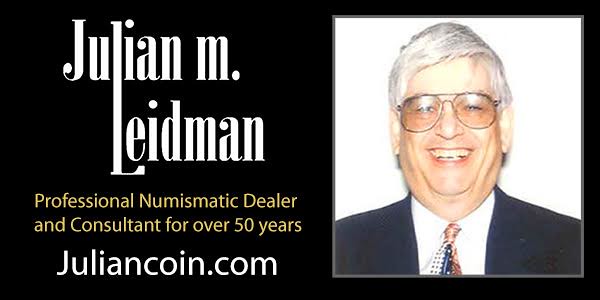
JOHN CALVIN GITCHELL (1828-1868)
John Calvin Gitchell (1828-1868), was born on December 22, 1828, son of Ezra B Gitchell (1800-), and Hannah (1788-).
Mitchell was born and raised in Boscawen where he was a student in the Boscawen Academy in 1846. He joined the Army during the Civil War. His life's career was as a cabinet maker, woodcarver, mechanic, and a farmer who grew corn, oats and barley. He wrote letters to editors of farming periodicals both giving and seeking agricultural advice.
He was a member of the Freemasons.


 Correspondence of twenty-one year old John C. Gitchell to his young friend, the twenty-one year old, George Hilliard Davis (1836-1868), postmarked
Boscawen, Merrimack County, New Hampshire, June 18, 1857, cover franked with scarce Scott #11. The two page letter begins with recollections of Election Day at
Concord asking Davis if he still has his coin collection he spoke about and if so will he sell it or any part of it to him. Gitchell desires to collect the
colonial Fugio and Washington Cents and directly asks Davis about them
Correspondence of twenty-one year old John C. Gitchell to his young friend, the twenty-one year old, George Hilliard Davis (1836-1868), postmarked
Boscawen, Merrimack County, New Hampshire, June 18, 1857, cover franked with scarce Scott #11. The two page letter begins with recollections of Election Day at
Concord asking Davis if he still has his coin collection he spoke about and if so will he sell it or any part of it to him. Gitchell desires to collect the
colonial Fugio and Washington Cents and directly asks Davis about them
On June 1, 1863, he joined the 7th Regiment New Hampshire Volunteers. On December 3, 1865, he married Seibert George Sweatt, at Webster, New Hampshire.
He died September 17, 1868, three months before his 40th birthday.
To read the complete article, see:
GITCHELL, JOHN CALVIN
(https://sites.google.com/a/numismaticmall.com/www/numismaticmall-com/gitchell-john-calvin)
The entire inventory of the Lupia Numismatic Library is for sale. Individual items will be available before the remaining archives are broken up into parcels sold at philatelic auctions in the U. S. and Hong Kong. Check NumismaticMall.com frequently as dozens of new items with estimates will be posted daily until everything is sold.
All inquiries will be given prompt and courteous attention. Write to: john@numismaticmall.com .
SILVER DOLLAR KING JOHN HIGHFILL
CDN Publishing contributing editor Joshua McMorrow-Hernandez wrote an article interviewing John Highfill of the National Silver Dollar Roundtable. Here's an excerpt; see the complete article online. The Donnie Osmond story is a riot! -Editor
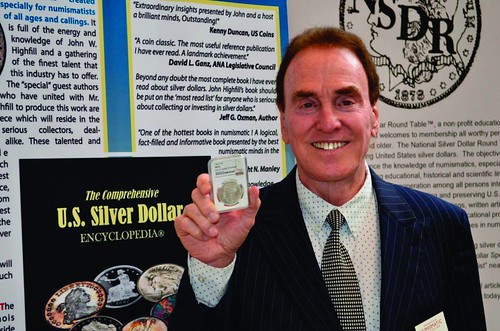 John Highfill is known as a silver dollar guru. Having founded the National Silver Dollar Round Table in 1982 and a decade later published his
landmark 1,200-page tome, The Comprehensive U.S. Silver Dollar Encyclopedia (Oklahoma Coin Exchange, 1992), Highfill is indelibly linked to numismatics.
It's a reputation he has only further cemented by serving on the boards of governors for significant organizations like the ANA and ICTA.
John Highfill is known as a silver dollar guru. Having founded the National Silver Dollar Round Table in 1982 and a decade later published his
landmark 1,200-page tome, The Comprehensive U.S. Silver Dollar Encyclopedia (Oklahoma Coin Exchange, 1992), Highfill is indelibly linked to numismatics.
It's a reputation he has only further cemented by serving on the boards of governors for significant organizations like the ANA and ICTA.
In so many ways, Highfill isn't your ordinary numismatist—and not just because he's risen to the top of the hobby. The 76-year-young Highfill can still run cartwheels around his “cartwheels,” and that's in part because he's learned how to roll with the punches. This renaissance man has been as successful outside of coin collecting as he's been in numismatics. During his days in the record industry, he once rubbed elbows with the likes of popular artists Elvis Presley, Kenny Rogers, Karen Carpenter, and Donny Osmond. He later had a lucrative brush with the famous 1990s-era plush collectibles known as Beanie Babies. According to Highfill, the numerous successes he's enjoyed in his long and colorful career has simply been a matter of “luck.” Maybe so… Or, perhaps, he's just thought outside the box all of these years.
... 1982, that was the beginning of the National Silver Dollar Roundtable. In 1982, we were in Houston, Texas, I had a meeting with Ken Bressett and Leonard Albright from ANACS. And the controversy at the time, when they were still using pictures of the coins in a Ziploc bag or whatever. It was all nuance. At the time, they had the position that the grade on the back of the coin had nothing to do with the grade for the rest of the coin, and they weren't double grading it. We had some disagreements on the grading, and I said I had a bunch of guys who were with me on the grading. And somehow, I become the leader of these guys, and that's when I formed the National Silver Dollar Roundtable, and I signed up 100 guys right there at the show.
I've always been about education and promoting learning—the NSDR was founded on those principals. I've also done over 100 seminars. Well, eventually we began working in a new grade—64. We were the founders of the “64” grade. And within a year so, Greysheet began reporting prices for the 64 grade and so. And now we've got 61, 62, 63, 64, 65, 66, so on. I've also been on the Board of Governors of the ANA, ICTA, and NSDR. And last year my organization awarded me with a legacy award, the John W. Highfill Lifetime Achievement Award. And I've got to admit, that honor felt pretty good.
To read the complete article, see:
The Kaleidoscopic Career of John Highfill
(http://blog.greysheet.com/the-kaleidoscopic-career-of-john-highfill/)

ROYAL CANADIAN MINT ARTIST CLAIRE WATSON
Local and small-town newspapers are often great sources of information on coin designers. Here's an interview with the designer of Canada's St. Lawrence Seaway commemorative coin from the Tofino-Ucluelet Westerly News in Ucluelet, BC. -Editor

Tofino illustrator and artist Claire Watson designed a pure silver coin for the Royal Canadian Mint to commemorate the 60th anniversary of the Saint Lawrence Seaway.
The special edition coin, says Watson, was a venture outside her creative comfort zone, which ultimately led to one of her greatest accomplishments to date.
“I remember getting really excited five years ago when I won the Whale Festival poster. This coin is a bit of an interesting step up,” Watson told the Westerly News from her floating home, a wooden sailboat called ‘Razmur'.
Last winter, a creative director from the Royal Canadian Mint reached out to Watson to see if she would like to be added to their pool of artists.
“Then, two months later, I got another call asking if I wanted to participate in the contest to submit designs for the Saint Lawrence Seaway,” Watson recalls. “To do the [initial] sketch was pretty simple. I did everything on my iPad with Procreate and a pen. I submitted my design and got a call a few days later saying that I had won it.”
Apparently, notes Watson, it is rare for a first-time contender to be selected.
“I was quite blown away that I won it,” she said.
Watson's design provides a water-level view of the Saint Lawrence Seaway, where a ship moves through one of 15 lock systems. A split maple leaf and star symbolizes the Seaway as a partnership between Canada and the United States and the anchor is a special tribute to all who oversee the safe and efficient passage of marine traffic through our waters.
“The Montreal skyline is tucked in there really small. Originally, my design had more landscape in the background, but then I changed it more. It's amazing how much detail they got in there,” said Watson, who is known for being the Tofino Time magazine's illustrator queen of the colouring page.
To read the complete article, see:
West Coast artist Claire Watson designs
coin for Royal Canadian Mint (https://www.westerlynews.ca/community/west-coast-artist-claire-watson-designs-coin-for-royal-canadian-mint/)
Nice design! Here are images of the coin and sketch from the artist's web site. -Editor


 Soooo, guess what? Yeah thats right… I've been MINTED! I can't tell you how proud and honoured I feel to have designed my first COIN for the Royal
Canadian Mint. Not in a million years (as a small town west coast island girl) did I ever think this would happen, and I've been bursting at the seams with
this little secret for the past YEAR. The final product may be small in physical size, but it is definitely one of the BIGGEST highlights to my career thus
far.
Soooo, guess what? Yeah thats right… I've been MINTED! I can't tell you how proud and honoured I feel to have designed my first COIN for the Royal
Canadian Mint. Not in a million years (as a small town west coast island girl) did I ever think this would happen, and I've been bursting at the seams with
this little secret for the past YEAR. The final product may be small in physical size, but it is definitely one of the BIGGEST highlights to my career thus
far.
As you know my usual subject matter is much more nature oriented, but this was a really interesting challenge to do. I have a full history around boats and ships… everything from growing up around or on the water most of my life, to my parents being involved with the Merchant Navy and Cruise Ships, and even my great great great uncle worked on and survived the sinking of the Titanic! I grew up hearing many maritime stories, and was surrounded by shipping paraphernalia so I certainly felt a familiarity with it.
To read the complete article, see:
http://clairewatson.com/studioclairewatsoncom//first-coin-design-for-the-royal-canadian-mint

HARVEY STACK'S NUMISMATIC FAMILY, PART 48
Harvey Stack's blog series focuses on living in a numismatic family. Here is part 48. Thanks, Harvey. -Editor
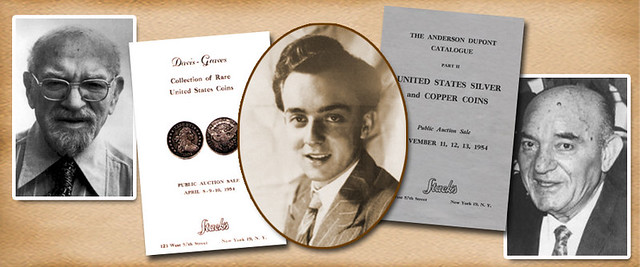
The year 1968 saw important changes in the entire numismatic world. Attitudes toward precious metals shifted, several important collections entered the market, the extensive J.K. Lilly Collection joined the National Numismatic Collection, and the public's interest in collecting both domestic and world coins flourished, infusing the coin marketplace with renewed energy. Our success in the case regarding the restrictions on the importation of gold, also encouraged collectors of world and ancient coins, increasing both buying and selling, which had a positive effect on the numismatic market.
Additionally, the revaluation of gold and silver helped build the public's interest in these metals. The Treasury revalued gold from $35 an ounce to $38.50 and the value of silver rose about 20% of its original base price of $1.19 and kept climbing. Speculation in silver coins, such as dimes, quarters, half dollars, and silver dollars became a driving force on the market and had a direct effect on the value of precious metal and circulating coins. Even silver certificates were sold at a premium in the early part of 1968. All these factors had a positive effect as the general public searched through loose change, emptied their piggy banks and got more from the sale of the metal, than the face value. Coin dealers, hock shops and jewelers were inundated with people redeeming their silver coins.
Adding to the building excitement of the numismatic world was news of the Josiah K. Lilly Collection, a massive collection of gold coins. After we prepared an inventory, Schulman and Kosoff provided the appraisal and an initial market value was determined for the collection. The individual coins (in 1968 dollars), were valued at $4.5 million, but the collection as a whole was appraised at $5.5 million for its vastness and completeness. Now the executors were tasked with finding a buyer or selecting an auctioneer. Dr. and Mrs. Clain-Stefanelli examined the collection with the intention of securing it for the National Numismatic Collection at the Smithsonian. They worked with several senators and congressmen and were able to convince them that acquiring the J.K. Lilly Collection, with its thousands of gold coins, would result in a world class national collection. In addition, they cautioned that allowing it to be lost or broken up by private auction and sale would be foolhardy, as its scope could never be duplicated.
The Congress of the United States voted and acquired the collection for the initial appraisal of $5.5 million. To sweeten the deal for the estate, by proclamation the government “technically removed it from the estate” as if it had been gifted to the Smithsonian; the $5.5 million was credited to any taxes that the estate owed. It was a great deal for all. I was part of the committee who helped the Smithsonian negotiate the deal. I was honored to be present at the opening day of the exhibit; helping to secure this major addition to our national collection is a continued source of pride for me.
In the fall of 1968 the famous R.L. Miles, Jr. Collection of United States gold, silver and copper coins was consigned to us at Stack's. It had been assembled over four decades, and many of the coins had been supplied by Stack's privately or through our public auctions.
With our help at Stack's, R.L. Miles Jr. assembled as complete a collection of United States coins, gold, silver, and copper as he could from the coins that were available during his collecting years. And, indeed, it grew into a major, comprehensive collection by the time it was to be offered by public auction. Miles had been nicknamed Skinny by his classmates in high school and college when he played on their football teams, and at Stack's we were permitted to use this nickname with him. In my next article I will tell more of this great person and his marvelous collection.
To read the complete article, see:
Harvey Stack Remembers: Growing up in a Numismatic Family, Part
48 (https://www.stacksbowers.com/News/Pages/Blogs.aspx?ArticleID=harvey-stack-remembers)
To read the earlier E-Sylum article, see:
HARVEY STACK'S NUMISMATIC FAMILY, PART 47
(https://www.coinbooks.org/v22/esylum_v22n26a22.html)

HONG KONG COIN SHOW AUGUST 23-25, 2019
Here's an excerpt from the press release for next month's Hong Kong Coin Show. -Editor

Despite the dynamic global economic environment, the purchasing power of collectors remains strong, which bodes well for the 6th Hong Kong Coin Show. As the leading numismatic fair in Asia, the Hong Kong Coin Show strives to move the numismatic industry forward. This is reflected by multiyear efforts to recruit new exhibitors from different countries, including Colombia, Nepal and Paraguay, and the growth of different numismatic events including seminars and workshops as well as a guided tour. The three-day show offers much more than might be expected; it not only provides opportunities to buy and sell, but also the chance to learn more about the hobby and the history behind the various collectibles.
To attract the attention of both exhibitors and potential visitors, the event has revamped the website and is reaching out through social media, including a Facebook fan page, Instagram and LinkedIn, etc. The social media accounts are updated weekly so that fans and newbies know the latest news of the industry and the event. Visitors can easily buy tickets online and pick them up at registration. Arriving is easy, just grab your ticket and you can immediately be part of the wonderful world of numismatics!
Were you unable to attend the March event? No worries – the 7th Hong Kong Coin Show is coming right up August 23 - 25, 2019. The HKCS welcomes people from all walks of life to join in the numismatic fun!
What is Hong Kong Coin Show (HKCS)?
 Twice each year, active coin dealers and collectors converge on the 18th Floor of The Mira Hotel in Hong Kong for an exciting numismatic event. The
biannual Hong Kong Coin Show (HKCS) takes place in March/April and in August and features not only buying and selling, but also seminars, workshops,
exhibitions, and a guided tour. This well-attended event is organized by four partners: Stack's Bowers and Ponterio Co. Ltd., Spink & Sons Ltd., Shouxi.com
and Coin-In-Coin, all leading companies in their respective fields. The HKCS is regarded as the top numismatic show in Asia.
Twice each year, active coin dealers and collectors converge on the 18th Floor of The Mira Hotel in Hong Kong for an exciting numismatic event. The
biannual Hong Kong Coin Show (HKCS) takes place in March/April and in August and features not only buying and selling, but also seminars, workshops,
exhibitions, and a guided tour. This well-attended event is organized by four partners: Stack's Bowers and Ponterio Co. Ltd., Spink & Sons Ltd., Shouxi.com
and Coin-In-Coin, all leading companies in their respective fields. The HKCS is regarded as the top numismatic show in Asia.
Since its inaugural show in August 2016, HKCS has grown to include over 100 top numismatic organizations and individuals from over 45 countries and regions. The three-day show attracts over 5,000 visitors, providing a solid client base for trade and exchange of ideas. The HKCS helps to make Hong Kong a world-class numismatic hub for auctions and coin shows. The show sets the standard as Hong Kong moves forward as a world-class coin center and an enhancement to numismatic globalization.
Passes:
Early Bird Pass: HKD300. Entry into the show at 9:00 am on the first day, and unlimited attendance at the show for three days. One Day Pass: HKD20. Entry into
the show at 11:00 am on the first day (if you buy the first day pass) and unlimited access to the show on the day of the pass.
RSVP:
hongkongcoinshow.com/registration
email: info@hongkongcoinshow.com Phone: +852 3952 3031

STEPHEN ALBUM 4TH INTERNET-ONLY AUCTION
Here's a press release with a few highlights from the Stephen Album auction starting Monday July 15, 2019. -Editor
Stephen Album Rare Coins has published their 4th Internet-Only Auction. Bids can be placed now on the bidding website, and live bidding is also available during the live session which begins at 10:00am PDT on Monday 15 July 2019. The sale features exactly 600 individual coin lots with starting prices ranging from 20 USD to 500 USD.
The coins in the sale range from all areas and time periods, including ancient coins, medieval Islamic coins, modern machine-struck coins from all continents, as well as a small number of modern coin issues.

One category that is expected to perform well is China, which includes a small selection of coins from the Don Erickson Collection of Chinese Coins. Totaling approximately 80 coins, these lots consist of mostly PCGS graded minor coinage from the Republican period as well as provincial issues. The majority of the coins are in choice grades.
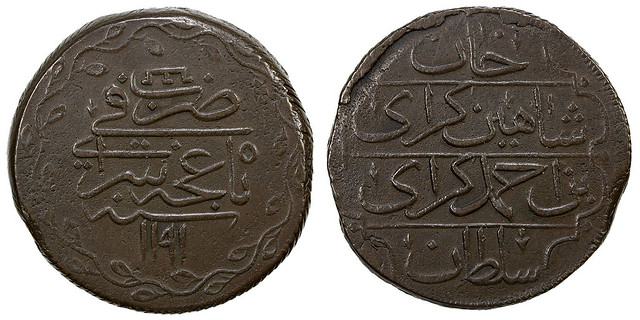
Another fascinating grouping is a listing of 34 lots of the Giray Khans, a dynasty that ruled in Crimea from the 15th to 18th century. Included are many rare rulers and types that savvy collectors will take note of.

An additional single highlight is a rare variety of a United States colonial cent from New Jersey, which as of this writing has already been bid up to 850 USD by pre-sale bidders.
It is possible to bid prior to the auction, and it is also possible to bid live during the auction as the lots hammer down one at a time.
All bids must be placed through the online bidding website at: www.sarc.auction

NUMISMAGRAM MEDAL SELECTIONS: JULY 2019
Jeremy Bostwick from Numismagram passed along these highlights from his recent addition of new items to his website. Thanks. In addition to those below, there are a few automobile types, a couple WWI-related medals, some rather interesting childbirth pieces, and another soccer medal. -Editor
1937 Soccer silver Plaque

100697 | FRANCE & CZECHOSLOVAKIA. Soccer silver Plaque. Issued 1937 for the amateur match between France and Czechoslovakia on 11 April (47x63mm, 89.69 g, 12h). By A. Lafleur. FÉDÉRATION FRANÇAISE / de FOOTBALL ASSOCIATION / INSTITUÉE le 7 AVRIL / – 1919 –, Victory standing left, holding wreath, palm frond, scroll, and olive branch, and resting hand upon basis with coat-of-arms to right / VIS ANIMI CVM CORPORE CRESCIT (the strength of the soul rises with that of the body), soccer scene; below, cartouche inscribed FRANCE-TCHÉCOSLOVAQUIE / (AMATEURS) / –TOURS– / 11 AVRIL 1937 in four lines and surmounted by soccer ball between laurel and oak branches. Edge: «hallmark» ARGENT. Mint State. Light gray toning with matte surfaces; a few scattered marks and bruises in the fields, most notably on the obverse at the top. $395.
In 1933, the current professional soccer league in France, Championnat de France de football, often more simply known as Ligue 1, was created. The following year, the Fédération française de football (FFF), formerly the Fédération française de football association (FFFA), created a championship for the numerous amateur teams around the nation, with the first contests being played in 1935. During pool play for the championship's third year in 1937, the French amateur team also participated in a friendly against the team from Czechoslovakia, the occasion for this plaque.
Of further interest, the designer of this plaque, Abel Lafleur, also designed the original World Cup, known then as the Jules Rimet Cup. At the time, FIFA rules stated that a winning country may keep the trophy following their third win, which Brazil did in 1970. The current rules allow for no such permanent awarding of the World Cup in order to protect it. Sadly, the original designed by Lafleur was stolen in Rio de Janeiro in 1983, never to be seen again and likely melted by the looters.
Impressive piece. I'd never seen this before. -Editor
To read the complete lot item see:
100697 | FRANCE & CZECHOSLOVAKIA. Soccer silver Plaque.
(https://www.numismagram.com/product-page/100697)
Sinking of the Lusitania Medal

100683 | UNITED STATES & FRANCE. Bronze Medal. Issued circa 1920. The Sinking of the RMS Lusitania (53mm, 76.92 g, 12h). By R. Baudichon in Paris. VLTRIX AMERICA JVRIS (America, the defender of the just) / 1917 USA 1918, upper part of the Statue of Liberty rising from the Atlantic Ocean, holding sword in place of torch / LVSITANIA MAY 7 1915, stern of the Lusitania above the ocean, in the process of sinking; capsized lifeboat in foreground; above, vignette containing a drowning child. Edge: «hallmark» BRONZE. Jones, Dance of Death, 27; The Art of Devastation, p. 310, 99. Choice Mint State. Attractive yellow-brown surfaces, with a pleasing matte nature. A powerful and historically interesting piece relating to America's build up to World War I. $565.
Not long after the German warning against sea travel into her 'war zone' declared upon Great Britain, a popular liner–the RMS Lusitania–was torpedoed 11 miles off the coast of Ireland, where over 60% of her passengers, some of whom where Americans, were killed. Serving as a rallying cry against the German Empire, this action solidified American involvement in World War I.
Terrible tragedy. Great medal! -Editor
To read the complete lot item see:
100683 | UNITED STATES & FRANCE. Sinking of the Lusitania bronze Medal.
(https://www.numismagram.com/product-page/100683)
Red Crescent Zinc Award Medal

100695 | TURKEY. Red Crescent zinc Award Medal. Issued 1917 (AH 1335) for humanitarian engagement at the Red Crescent Exhibition in Istanbul [unawarded] (59mm, 76.06 g, 12). By G. Herrmann in Wien. Female attendant left, cradling and giving water to Turkish soldier; Süleymaniye Mosque and rising sun in background / Crescent, Arabic inscription, and dates (AD and AH); ornate cartouche below; oak branch to left. Edge: Plain. Pere 1153; Wurzbach 8870. Choice Mint State. Steel gray surfaces, some scattered marks and spots of discoloration consistent with zinc. Very rare. $435.
The Red Crescent emblem was first utilized for humanitarian work during the Russo-Turkish War from 1876-1878, acting as an analog to the International Red Cross. The latter used a color reversal of the Swiss flag as its banner, and the Red Crescent followed suit, adopting a color reversal of the Ottoman Empire's flag for its standard. A third symbol, the Red Crystal, is utilized by Israel in a similar fashion and function. In each case, the inherent religion of those assisting or being assisted is of concern in comparison to the aid provided.
I'd never seen this medal before. The zinc material makes it look dark and foreboding, but it's a decent design. -Editor
To read the complete lot item see:
100695 | TURKEY. Red Crescent zinc Award Medal.
(https://www.numismagram.com/product-page/100695)
1931 Dresden International Health Exposition Medal

100704 | GERMANY. Dresden enameled gilt bronze Medal. Issued 1931. Commemorating the International Health Exposition, held in Dresden for the second time from May–October 1930 and again in May–October 1931 (70mm). By A. Mazotti. Colorized eye within sunburst / INTER / NATIONALE / HYGIENE / AUSSTELLUNG / DRESDEN / 1930/31 in six lines; cross above and below. Edge: Plain. Mint State. Virtually as made, with great enameling on the obverse; a few scattered marks. An incredibly interesting and transfixing piece of medallic art. Extremely rare. $345.
Serving as a follow-up to the first Hygiene expo, organized by Karl August Lingner and held in Dresden, this expo was held in a building which would serve as the German Hygiene Museum following the expo. One of the biggest attractions was the Gläserner Mensch, or transparent man—the basis from which many subsequent copies have been made. A further allusion to the previous expo was in the form of the logo—a mesmerizing eye, originally used by Franz Stuck in his poster, and revived by Willy Petzold in a similar fashion, similar to that used for this medal.
Eye like it! -Editor
To read the complete lot item see:
100704 | GERMANY. Dresden enameled gilt bronze Medal.
(https://www.numismagram.com/product-page/100704)

ARCHIVES INTERNATIONAL SALE #54 SELECTIONS
Here some items that caught my eye in the upcoming Archives International sale. -Editor
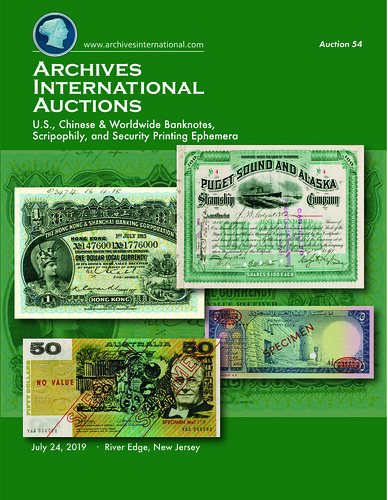

Lot 210: 942 Government of Gibraltar 5 Pound Note

Gibraltar... 1.6.1942, £5, P-16a, Issued banknote, Brown on m/c, Rock of Gibraltar at bottom middle, back brown with arms, S/N C059289, Crisp Choice VF. Sharp corners, bright colors, deep embossing, excellent centering with jumbo margins and fresh appearance enhance this totally original note from a new find. W&S
To read the complete lot description, see:
Government of Gibraltar, 1942,
1934 Ordinance, 1938-42 Banknote Issue.
(https://auction.archivesinternational.com/Government-of-Gibraltar-1942-1934-Ordinance-1938-42-Banknote-Issue_i33823363)
Lot 220: 1898 Banco Americano de Guatemala 1 Peso

Guatemala. Issued 1 Peso, 1898, P-S111a, two seated allegorical women representing Agriculture and Commerce, Choice Fine, ABNC
To read the complete lot description, see:
Banco Americano de Guatemala. 1898. Issued
Banknote. (https://auction.archivesinternational.com/Banco-Americano-de-Guatemala-1898-Issued-Banknote_i33823373)


Lots 79 and 226
Lot 79: 1917 China Cloth Note
China, 1917, 1000 Wen, Beyer SAN-0390, Blue printing with red seals and overprints on face, back blank, First time seen by describer. Ornate borders with
different figures, cloth with toning and light stains, small pieces of thread are loose on the borders. Back with slight staining possibly from previous
mounting. A cloth example of this type of banknote is extremely rare. Fine condition with toning and light stains, still very attractive with bright colors and
legible text and seals
To read the complete lot description, see:
San Le Tang, 1917 Private "Cloth or
Silk" Banknote Rarity (https://auction.archivesinternational.com/San-Le-Tang-1917-Private-Cloth-or-Silk-Banknote-Rarity_i33823232)
Lot 226: 1827 Haiti 10 Gourdes Uncut Sheet
Haiti, Uncut sheet of 3 notes, 10 Gourdes, Thick Paper, P-4b, Issued, black on light brown paper, S/N Unknown, With Arms, PMG graded About Uncirculated 50 NET
with notation of backed, Ink burn, thinning, (Professionally with what appears to be silk paper), there are pieces missing in the middle of each note,
extremely rare in this format. Please inspect, this is being sold "As is" no returns accepted.
To read the complete lot description, see:
Republique d'Haiti,
1827 First Issue, 10 Gourdes Uncut Sheet of 3 Notes.
(https://auction.archivesinternational.com/Republique-d-Haiti-1827-First-Issue-10-Gourdes-Uncut-Sheet-of-3-Notes_i33823379)
Lot 340: 1949-1954 Philippines 100 Pesos Specimen

Philippines, 100 Pesos, P-Unlisted but similar to P-139 but with Security BNC imprint and not TDLR imprint which were the issued notes, Uniface essay specimen, Black on gold, small date on top left border "6-24-(19)54", Gem Uncirculated condition. Rare and interesting. An unreleased Security Bank Note Co. design. SBNC.
To read the complete lot description, see:
Central Bank of the
Philippines, 1949-1954 Essay Specimen-Proof Banknote.
(https://auction.archivesinternational.com/Central-Bank-of-the-Philippines-1949-1954-Essay-Specimen-Proof-Banknote_i33823493)
Lot 385: Switzerland 1000 Francs Specimen Note
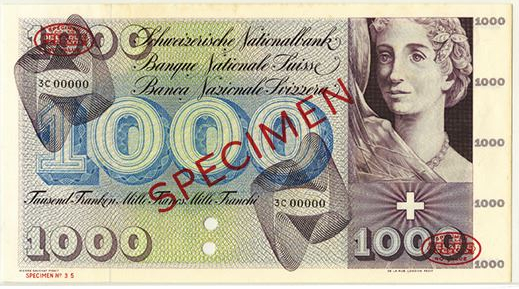
Switzerland. ND, 1000 Francs, P-52s, Specimen and Oval TDLR overprints on top left and lower right corners, Minor Mounting remnants on back right margin that is difficult to view. S/N 3C00000 35, PCGS graded Choice New 63, POC, TDLR.
To read the complete lot description, see:
Banque Nationale Suisse, ND (1954-74) Specimen Banknote.
(https://auction.archivesinternational.com/Foreign-Banknotes_i33823538)
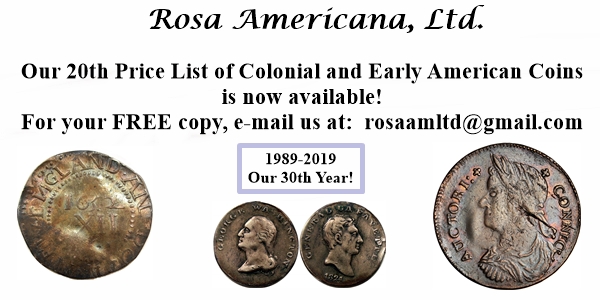
FOURTH GARRIDEB NUMISMATIC SHERLOCKIAN DINNER
Greg Ruby publishes The Fourth Garrideb blog on the numismatics of Sherlock Holmes. He passed along this announcement of the group's fifth anniversary dinner. RSVPs are due by August 12, 2019. -Editor
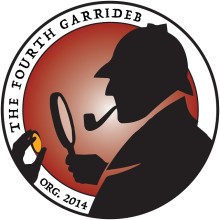 The Fourth Garrideb will be celebrating its fifth anniversary this year during our Numismatic Friends of Sherlock Holmes dinner during the World's
Fair of Money by the American Numismatic Association in Rosemont, Illinois. Our dinner will be held at 7 p.m. on Thursday, August 15, 2019, and we are hoping
you can join us.
The Fourth Garrideb will be celebrating its fifth anniversary this year during our Numismatic Friends of Sherlock Holmes dinner during the World's
Fair of Money by the American Numismatic Association in Rosemont, Illinois. Our dinner will be held at 7 p.m. on Thursday, August 15, 2019, and we are hoping
you can join us.
Our dinner will be held at Basilico Ristorante in nearby Norridge, approximately 3 mile and 10 minutes away by car from the Donald E. Stephens Convention Center, site of the World's Fair of Money.
For the first time ever, we will be in a private room for our dinner. Perhaps they have heard stories about past dinners with Sherlockians and/or coin collectors.
There is no agenda for the evening – no program, no quiz, no story discussions, well you get the idea. We do encourage attendees to offer up a toast or two, to a Sherlockian or numismatic topic of their choosing.
Tradition has TFG issuing some sort of souvenir at these dinner to be presented to all in attendance and have become highly collectible and sought after in some corners.
We have invited members of the many Chicagoland area Sherlock Holmes groups to join us for an evening of good food, good drink and good conversation and friendship. An attendee at one of our past dinners commented that “It has been a long time, if ever, that I have enjoyed the company of ‘strangers' at dinner who were so bright, so engaging, and so talented.”
To read the complete article, see:
TFG to Celebrate 5th Anniversary in Chicago on August
15 (https://fourthgarrideb.com/2019/04/23/tfg-to-celebrate-5th-anniversary-in-chicago-on-august-15/)
THE BOOK BAZARRE
CANADA'S FIRST COINS
George Manz is a Fellow of the Royal Canadian Numismatic Association and President of the Regina Coin Club. He submitted this article on Canada's First Coins. Thanks. I added an image of a specimen cent from the Heritage site. -Editor


https://coins.ha.com/itm/canada/canada-victoria-specimen-1-cent-1858-sp65-red-and-brown-pcgs-/a/3041-29001.s
The first coins minted for Canada are dated 1858. But Canada in 1858 was much smaller than it is today. Back in 1858, the Province of Canada consisted of Upper Canada (Canada West) and Lower Canada (Canada East). These small British colonies were in the southern part of what are now the provinces of Ontario and Quebec.
After 1837-1838 rebellions in favor of responsible government in Lower Canada and Upper Canada were defeated, Lord Durham reported that only a united government would end the animosity. And so the Act of Union of 1840 gave each province 42 seats in the Legislative Assembly of the united Province of Canada.
Eventually, moderate reforms were enacted such as responsible government and making French one of two official languages.
One of the duties of the government of the Province of Canada was to issue coins. And what coins they were. The series of coins dated 1858 were issued in four denominations including large cents, silver 5 cents, silver 10 cents and silver 20 cents. All were minted in England.
The obverse of each coin depicted Queen Victoria wearing a laurel wreath in her hair. But by 1858, Victoria was an overweight and much older looking woman than depicted on these coins.
The bronze large cents are my favorites in the series, partly because the coins were made to not only represent the value of the coin, but also because they were designed for other functions as well. Each cent weighed exactly 4.54 grams, which meant that there were 100 cents in a pound. Also, the coins measured 25.4 mm, so that if you put 12 of them edge to edge, they would measure exactly one foot in length.
The silver 5 cents, 10 cents and 20 cents were made of Sterling silver. Interestingly, the 20 cents is a one-year denomination. Within a few years, the government decided that it would be replaced by 25 cents coins.
A rare Specimen set of these 1858 coins will be on display at the Regina Coin Club fall show on October 19-20, 2019 at the Turvey Centre, just north of Regina.
For more information on the show, see:
http://www.reginacoinclub.com/

UNOFFICIAL BORDER PATROL CHALLENGE COIN
In the current events department, here's an excerpt from a ProPublica article about a challenge coin making the rounds among the U.S. Border Patrol. -Editor


An unofficial commemorative coin has been circulating among Border Patrol agents at the U.S./Mexico border, mocking the task of caring for migrant children and other duties that have fallen to agents as families cross into the U.S.
On the front, the coin declares “KEEP THE CARAVANS COMING” under an image of a massive parade of people carrying a Honduran flag — a caricature of the “caravan” from last fall, which started in Honduras and attracted thousands of people as it moved north. (While the caravan included many women and children, the only visible figures on the coin appear to be adult men.)
The coin's reverse side features the Border Patrol logo and three illustrations: a Border Patrol agent bottle-feeding an infant; an agent fingerprinting a teen boy wearing a backwards baseball cap; and a U.S. Border Patrol van. The text along the edge reads “FEEDING ** PROCESSING ** HOSPITAL ** TRANSPORT.”
The coin appears to poke fun at the fact that many border agents are no longer out patrolling and instead are now caring for and processing migrants — including families and children.
Government officials told ProPublica the coin was not approved or paid for by the government, unlike official “challenge coins” that go through an agency approval process.
The coin is part of a tradition of unofficial “challenge coins” — which generally outnumber official ones — which are common in the military and law enforcement as a way for members to celebrate achievements and build camaraderie.
This article and other outlets describe the coin as mocking migrants, but as the article points out, it could also be a way for law enforcement personnel to vent frustration at tasks they feel aren't what they signed up for when taking the job. -Editor
Some agents say that childcare and support have an opportunity cost: Any time an agent spends driving a van full of children to a child-only facility, for example, is time not spent “in the field” apprehending people who are trying to get away.
“Us caring for kids and families, that's not the frustration,” Garza said. “Drugs coming into the country? That is a frustration. People with criminal records coming in and us not being able to catch them? That is a frustration.”
To read the complete article, see:
Border Patrol Agents
Are Passing Around A Commemorative Coin Mocking Care for Migrant Kids
(https://www.propublica.org/article/border-patrol-agents-are-passing-around-a-commemorative-coin-mocking-care-for-migrant-kids)

COINS OF THE REPUBLIC OF MINERVA
A short article on Curbed discusses the onetime micronation of the Republic of Minerva and mentions its coins. -Editor
 Fantasies of escaping society's problems often fuel utopian movements, but one bizarre—and mysterious—effort from the '70s to create a nation free of
government intervention caused nothing but trouble and sparked an international relations dispute.
Fantasies of escaping society's problems often fuel utopian movements, but one bizarre—and mysterious—effort from the '70s to create a nation free of
government intervention caused nothing but trouble and sparked an international relations dispute.
In 1972, the “utopian” Republic of Minerva made its first appearance in the New York Times in a story headlined “South Sea Reef Proclaimed a Republic by 3 Americans.” Michael Oliver, one of the three founders, explained that he wanted to create an “escape from high taxes, riots, drugs, and crime” and did it through an old-fashioned colonial land grab.
Oliver and his partners chose the Minerva Reef—named after a ship that was wrecked on it in the 1820s—which is about 450 miles south of Fiji and 260 miles east of Tonga. During low tide, it's only partially submerged. They intended to build a 400-acre artificial island over the reef and turn it into a resort that would “sparkle like a jewel in the blue South Pacific,” according to one of the Republic of Minerva's self-published newspapers. They hoped to attract tens of thousands of residents and base their governance structure on zero taxes, no welfare, no subsidies, and no economic intervention.
A coin collector and real estate investor, Oliver used much of his own wealth to establish the Republic of Minerva. Soon after sending a “declaration of independence,” another founder, Morris Davis, built a tower of stones on the reef and planted a flag—a golden torch set against a blue background—for the new “country” on it.
While The Republic of Minerva sounded like a fool's errand from the start, the dream of establishing micro-nations in the middle of the ocean still persists in the form of the Seasteading movement. Billionaire Peter Thiel, co-founder of PayPal and the software company Palantir, once tried to create his own floating country off New Zealand.
The ocean has long washed any sand that Oliver and his associates placed on the Minerva Reef. Some of his coins, however, are still available for sale.
By "still available for sale" they mean "show up on eBay once in a while". Have any of our readers attempted to build a set? How many coins are there? How were they marketed originally? -Editor
To read the complete article, see:
This failed utopia from the 1970s sparked an international
dispute (https://www.curbed.com/2019/7/12/20690898/republic-of-minerva-south-pacific-michael-oliver)
To read an earlier E-Sylum article, see:
MICRONATION STATECRAFT FOR DUMMIES (https://www.coinbooks.org/esylum_v17n43a21.html)

THE CASASCIUS PHYSICAL BITCOIN
This article from Altcoin Buzz discusses the history of the Casascius Physical Bitcoin and includes a catalog of denominations and types. -Editor
 Casascius Physical Bitcoins or Casascius coins are physical metal coins created by Bitcoin user Casascius (Mike Caldwell, Sandy, Utah, USA) and sold
until Nov 26, 2013. It contains an embedded piece of paper with digital Bitcoin value, covered by a tamper-resistant hologram. Casascius coins are available in
the denomination of 1, 10, 25, 100, and 1000 BTC increments.
Casascius Physical Bitcoins or Casascius coins are physical metal coins created by Bitcoin user Casascius (Mike Caldwell, Sandy, Utah, USA) and sold
until Nov 26, 2013. It contains an embedded piece of paper with digital Bitcoin value, covered by a tamper-resistant hologram. Casascius coins are available in
the denomination of 1, 10, 25, 100, and 1000 BTC increments.
Each Coin has its own Bitcoin address and a redeemable “private key” which is covered by a hologram. To read the private key inside the coin the person need to peel the hologram, once peeled and redeemed the coin will no longer have any Bitcoin value. These coins are designed for face-to-face transactions.
The initial success of the 1 BTC Coins inspired Mike to create physical bitcoins of other denominations
Suspension of sale
The Financial Crimes Enforcement Network (FinCEN), a branch of the Treasury Department, informed Casascius that minting physical coin and transmitting money
requires state license and federal level registration. And thus from Nov 27, 2013, onwards, the sale is suspended for items that contain digital bitcoins, the
current items in the sale does not contain bitcoins.
Fake Casascius Coins
There have been multiple reports of fake Casascius coins being circulated in the market. The counterfeit and unauthorized coins even appear to mimic the
spelling error from the Series 1 coins. Check out this bitcointalk link where the author compares an original Casascius coin with a fake one.
One should not accept Casascius Bitcoins if the hologram is damaged because the integrity of the coin depends upon the hidden embedded key code inside the hologram.
To read the complete article, see:
What is
the Casascius Physical Bitcoin? Exploring an important part of Bitcoin's history
(https://www.altcoinbuzz.io/bitcoin-and-crypto-guide/what-is-the-casascius-physical-bitcoin-exploring-an-important-part-of-bitcoins-history/)
You probably first read about these eight years ago in The E-Sylum. Anybody have one in their collection? -Editor
To read the earlier E-Sylum articles, see:
BITCOINS GO FROM VIRTUAL TO PHYSICAL (https://www.coinbooks.org/esylum_v14n45a22.html)
U.S. GOVERNMENT SHUTS DOWN PHYSICAL BITCOIN MINTER
(https://www.coinbooks.org/esylum_v16n51a14.html)

WHEN WAS THE FIRST EMPEROR NORTON SCRIP ISSUED?
Emperor Norton of San Francisco issued scrip notes or "bonds" that are quite rare and collectible today. John Lumea runs The Emperor's Bridge Campaign to keep alive the memory of this notable eccentric who issued proclamations published in local papers and reprinted worldwide, spreading his fame and bringing curious tourists who purchased the Emperer's notes as souvenirs. New research has revealed a reference to what could be the earliest known Emperor Norton bonds. Here's an excerpt from John's campaign blog article published July 10, I've added an image of a Norton note from an earlier E-Sylum article. -Editor
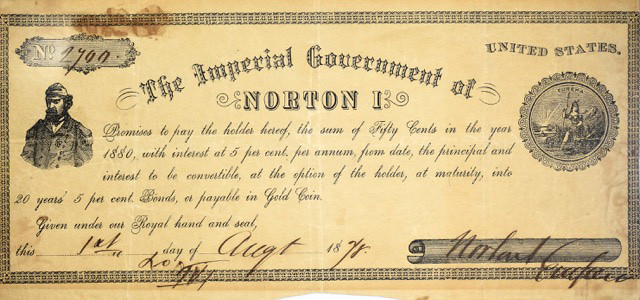
According to those who study the history and production of rare coins and currency — they're called numismatists — particularly to those who, within that already specialized field, are experts in Western Americana…
The earliest extant example of Nortonian scrip — promissory notes, or bonds, sold by the “The Imperial Government of Norton I", and signed by him — is dated 11 November 1870.
The 50-cent note was designed and printed — in red ink — by the firm of Cuddy & Hughes. It is in the collection of the California Historical Society.
In November 1870, the Emperor Norton had just started having his Proclamations published regularly in the Pacific Appeal, an African American-owned and -operated weekly newspaper which — as it happens — also was printed by Cuddy & Hughes. In fact, both the paper and the printer had their offices and operations in the same building: 511 Sansome Street, at the southwest corner of Sansome and Merchant (the latter of which now is called Mark Twain Street, at that location).
Six weeks after the Emperor sold his bond on 11 November 1870, he designated the Pacific Appeal as his official “weekly imperial organ.”
Western Americana specialists within numismatics seem generally to agree that the mutually beneficial relationships between both the Appeal and Cuddy & Hughes to Emperor Norton came together during this period — and that late 1870 is when the Emperor started selling his scrip.
So, I long have been mystified by the claim of Emperor Norton's biographer, William Drury — the author of Norton I: Emperor of the United States (Dodd, Mead & Company, 1986) — that the Emperor started selling scrip in June or July of 1869.
But, here's a document we hadn't seen: On the front page of its edition of 18 September 1867, the Daily Alta California newspaper reported the following:

To be sure, the Alta — led by its editor, Albert Evans — pen name, Fitz Smythe — practically originated the habit of writing fake proclamations and otherwise making journalistic sport of Emperor Norton. The paper did this for years.
But, this item doesn't read like a prank.
The details — bonds of “fifty cents, convertible into seven per cent” — line up with what the Emperor actually did.
What are we to make of this?
Perhaps someday a genuine Emperor Norton note dated 1867 will come to light. Be on the lookout! -Editor
To read the complete article, see:
Emperor Norton Scrip in 1867?
(http://www.emperorsbridge.org/blog/2019/7/10/emperor-norton-scrip-in-1867)
To read earlier E-Sylum articles, see:
EMPEROR NORTON'S GARDEN PARTY (https://www.coinbooks.org/esylum_v17n39a26.html) EMPEROR NORTON BOND IN KAGIN'S SALE (https://www.coinbooks.org/v21/esylum_v21n35a25.html)

THE COLORBLIND COUNTERFEITER
In the maybe-that's-not-such-a-good-idea department is this story from China about a colorblind counterfeiter. Thanks for Dick Hanscom for forwarding this Daily Mail item. -Editor

A 24-year-old man was arrested and jailed after he was caught producing counterfeit money at his home in south-west China.
The man, who suffers from colour blindness, had his girlfriend help him with the operation after watching a 'tutorial' and purchasing printing equipment online, according to Chinese reports.
Police said the couple in Suining, Sichuan province produced 2,000 yuan (£230) worth of counterfeit bank notes but couldn't spend a single bill because 'they looked too fake'.
The man had wanted to 'get rich fast,' and came up with the idea of printing his own money at home, according to Shangyou News.
Footage released by video news site Pear shows police officers raiding the couple's home and confiscating the counterfeit money including 1 yuan, 5 yuan, 10 yuan and 20 yuan bank notes.
Zhao later admitted to planning the counterfeit operation after watching a 'tutorial' online, Shangyou reported.
To read the complete article, see:
Colour-blind man, 24, is
jailed after printing counterfeit money 'so fake that no one would take the bills'
(https://www.dailymail.co.uk/news/article-7233279/Colour-blind-man-jailed-printing-counterfeit-money-fake-no-one-bills.html)
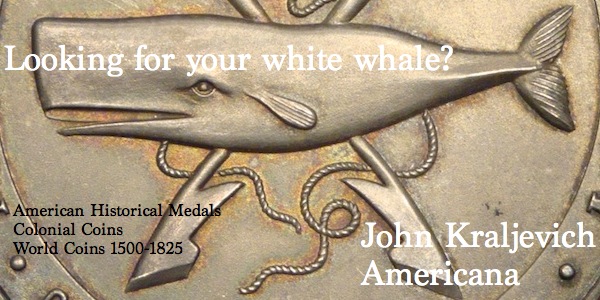
COLLECTIBLE STOCK AND BOND CERTIFICATES
David Sundman forwarded this Bloomberg Businessweek article on the market for collectible stocks and bonds. Here's an excerpt - be sure to see the complete article online. It has images of more stock and bond certificates (including the Trump Hotels & Casino Resorts), plus a great photo of dealer Bob Kerstein in his office in Chantilly, VA. -Editor

“I should have bought more Lehman” is not something you hear every day.
But it's an honest regret for Bob Kerstein, who makes a living buying and selling what traditional investors would consider worthless equities. During the financial crisis, JPMorgan Chase & Co. bought Bear Stearns Cos. for $10 a share. Kerstein will sell you one for $395. A share of Countrywide Financial Corp., taken over by Bank of America Corp. for less than $5 a share, will run you $199.95. Prefer fixed income? You can get yourself a piece of a vintage Countrywide collateralized mortgage obligation for $169.95.
Before computers took over markets, issuers of equities and bonds gave out paper certificates, usually featuring artwork that depicted the companies' business, which were shuffled among brokerage houses. (Some companies continued to put out certificates even after they became functionally obsolete.) Certificates of failed, acquired, or otherwise defunct companies were supposed to be thrown out. Some got diverted on the way to the dump or were found tucked away in long-forgotten file cabinets or safe-deposit boxes. A niche group of collectors in what's known as the scripophily market will pay top dollar for certificates of famous failures. The more epic, the better.
“What I used to say is, the flops are worth more dead than alive,” says Kerstein, a dealer in Virginia whose stocks and bonds can be found on Scripophily.com. “Like the Enrons. They were selling for a dollar or two apiece. Once the company died, they were selling for a couple hundred.”
In the past few years, there's been fresh interest in the equities and bonds of Donald Trump's failed casino company. A 1999 Trump Hotels & Casino Resorts Inc. stock certificate that's in “practically pristine” condition, featuring a head-and-shoulders portrait of the Donald hovering over the Atlantic City boardwalk, is available on EBay at a buy-it-now price of $800. The stock itself was delisted after trading for about a buck or two following the company's first trip to bankruptcy court in 2004.
Robert Schwartz, a dentist who splits his time between working on teeth and dealing in financial certificates and other collectibles, has sold a few Trumps in recent years, too, at his auction house Archives International Auctions. “I think some people are buying it because they love Trump, while the majority are buying it because it's a novelty,” he says.
Some of the demand from China is for shares that are remarkably American in flavor. Vintage certificates of the Kentucky Fried Chicken Corp. featuring a portrait of Colonel Sanders are usually sold quickly to buyers in China, where the fast-food chain has done a robust business since opening its first restaurant near Mao Zedong's tomb in Tiananmen Square in 1987. “Every time I put one online, I sell it for $150, $200 without even trying,” Schwartz says.
To read the complete article, see:
Collectors Are Shelling Out
$395 for Bear Stearns Stock Certificates
(https://www.bloomberg.com/news/articles/2019-07-09/collectors-are-shelling-out-395-for-bear-stearns-stock-certificates)
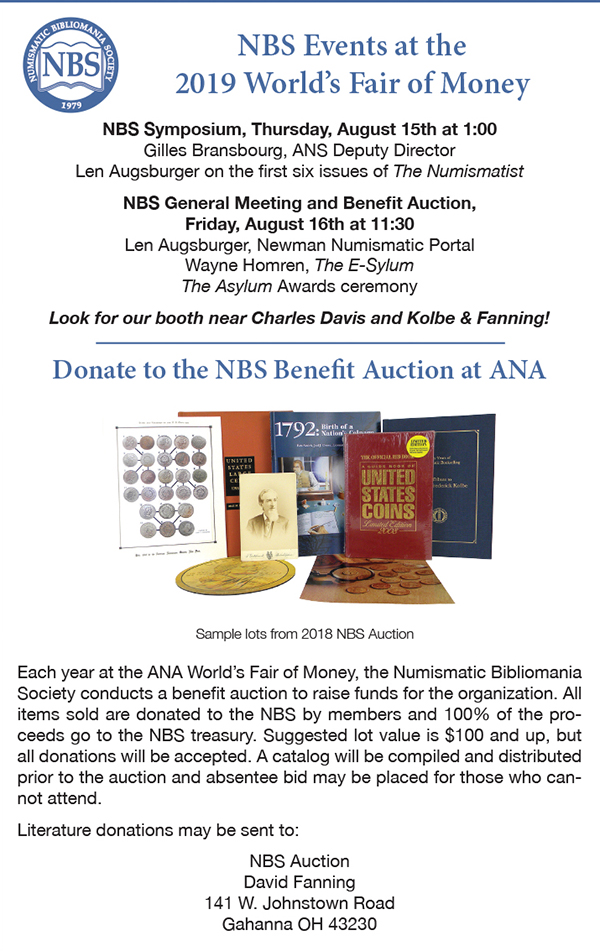
LOOSE CHANGE: JULY 14, 2019
Here are some additional items in the media this week that may be of interest. -Editor
US Mint Artists Challenged to Think Creatively
Don Scarinci published an article in Numismatic News encouraging U.S. Mint artists to think creatively about their coin designs. -Editor
The new crop of artists from the United States Mint's artist infusion program came together at the Mint's headquarters in Washington DC last week. They participated in a three-day intensive series of workshops that included viewing and studying Krause Publications' Coin of the Year (COTY) award winners for tips about how to create award-winning coins.
Joseph Menna, the new Chief Engraver and David J. Ryder, the new Mint Director, addressed the infusion artists as a group for the first time. Both expressed the importance of coin design and their commitment to support the artists to be the best they can be.
To read the complete article, see:
US Mint Artists Challenged to Think Creatively
(https://www.numismaticnews.net/article/us-mint-artists-challenged-to-think-creatively)
Creative Collections
Another Numismatic News articles, this time by Pat Heller encourages collectors to be creative in setting their goals for a collection. Here's a selection of ideas - see the complete article online for more. Some of these would be a real challenge! -Editor
“Outside the box” collections to consider:
- World coins issued in your birth year
- An example of coins of as many different languages as you can find
- Coins or paper money with all different monetary units (dollar, peso, franc, drachma, dinar, ducat, penny . . .)
- Coins or paper money depicting religious figures of your faith
- As many different coins as you can find with the denomination of “2”
- Coins from as many different nations as possible that depict a queen
- Coins and paper money that depicts the same person on both the obverse and reverse like a Lincoln Memorial Cent, Series 1976 and later US $2.00 Federal Reserve Note, or a Roman Emperor Nero Gold Solidus
- National bank notes of banks that were robbed by John Dillinger
- Issues of a particular coin or currency designer, or perhaps a designer of medals
- Instead of a type set or a first year of issue type set, how about a last year of issue type set
To read the complete article, see:
Start a Creative Collection
(https://www.numismaticnews.net/article/start-a-creative-collection)
Focus on Rarity
Never underestimate the power of rarity in coin valuation. Jeff Garrett wrote a great article on the NGC site comparing the price performance from 1982 to date of great U.s. rarities vs. much more common U.s. coins. -Editor
I recently dug through my library and found a copy of the 1982 Greysheet with a cover story on the sale of the Eliasberg gold coins. The article described prices realized as “very, very strong” and fierce bidding in all sessions.
Thirty years later, these prices seem like incredible bargains. Many of these coins would easily sell for $1 million-plus today, and most have increased by at least 10 times. Unfortunately, we cannot go back in a time machine to make these wonderful purchases. We can, however, use the Eliasberg sale as a lesson in collecting.
Below are the wholesale bids for some commonly traded coins in November 1982...
It is hard to believe that these commonly traded issues have performed so poorly as investments. This list is not an aberration or a selection of the worst-performing issues. A careful study reveals that nearly every issue with large numbers of known examples did poorly over a 30-year period. Coins that were very or extremely rare, however, saw tremendous price increases. This probably can be best explained by simple supply and demand.
To read the complete article, see:
Jeff Garrett: Focus on Rarity (https://www.ngccoin.com/news/article/7568/)
Video: No Small Change
Here's a video put together by the Harrisburg (PA) Coin Club combining footage of Hagerstown researcher Rick Lank and his wife speaking the Pennsylvania Association of Numismatists show together with their PowerPoint presentation on "No Small Change - The Impact of the Civil War on our Coins, Currency & Tokens". -Editor
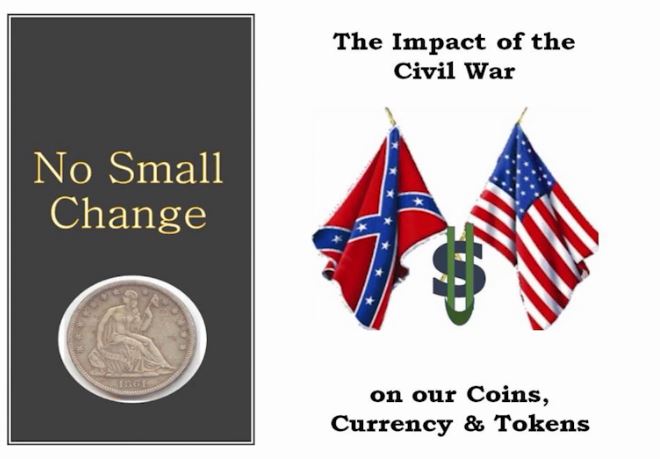
To watch the complete video, see:
PAN Presentation 2019
(https://www.youtube.com/watch?v=EFhtMwU8ZKA&feature=youtu.be)
Why are Nickels Bigger Than Dimes?
Numismatists know the answer to this of course, and it's something I often ask youngsters to see if they're really paying attention to our coins. I give this guy credit for at least noticing. QUICK QUIZ: who can write up a simple, easy-to-understand answer in as few words as possible? -Editor
Last night I stumbled upon a troubling realization about our American currency. But before I get into that, please ignore the fact that yesterday I forgot how much a dime was worth. That is so clearly not an important aspect in this scenario. And while you're forgetting that, humor me and ask yourself something, why are nickels bigger than dimes? Really think about it. Allow logic to take over, and then try to come up with a legitimate answer. Hopefully, you realized how shocking it is that our nation has survived for over 200 years without questioning why our nickels are bigger than our dimes but are somehow worth less?
P.S. The dime is also smaller than the penny.
To read the complete article, see:
Why are nickels bigger than dimes? A first hand
account (https://www.barstoolsports.com/newyork/why-are-nickels-bigger-than-dimes-a-first-hand-account)
What's a Strip Club Without Dollar Bills?
Found via News & Notes July 9, 2019 from the Society of Paper Money Collectors. -Editor
This job exists because of the large, untraceable piles of dollars—which, according to the most adamant financial experts, are not long for this world. Cashlessness is trending around the planet.
A club makes the majority of its profits in credit card charges at the door, the bar, and the private rooms; the cash that flies around has always belonged to the strippers. On the floor, customers hand out hundred dollar bills as liberally as business cards.
But without cash, the club I work at is free to exploit. Cash handed directly to a dancer gets pocketed, but credit card charges are skimmed—and because workers are more or less off the books, we have no recourse to contest absurdly high fees.
To read the complete article, see:
What's a Strip Club Without Dollar Bills?
(https://jezebel.com/whats-a-strip-club-without-dollar-bills-1834986232)
The New Gold Prospectors
An article on Topic highlights the latest incarnation of gold prospecting as a modern-day hobby / diversion / obsession / quixotic quest. I pulled a few quotes to set the stage, but read the whole article - it's an interesting story. -Editor
Every year, members of the Gold Prospectors Association of America pack up their RVs in search of adventure, friendship, and a bucketful of pay dirt.
The GPAA was founded in 1968 by prospector George “Buzzard” Massie to “preserve and promote the great heritage of the North American Prospector.” By all accounts, Massie was a gregarious, larger-than-life individual who helped bring gold prospecting back into the public consciousness.
On YouTube, gold-panning tutorials have racked up millions of views, and product-testing clips of new sluices and highbankers have been eyeballed by tens of thousands of people.
To read the complete article, see:
The New Prospectors (https://www.topic.com/the-new-prospectors)
FEATURED WEB SITE: COINFLATION
This week's Featured Web Site is suggested by Ken Fritsch. Coinflation.com is owned by Collectors Universe.Coinflation.com is an informational website providing precious metal values and the intrinsic values of individual coins.

www.coinflation.com

